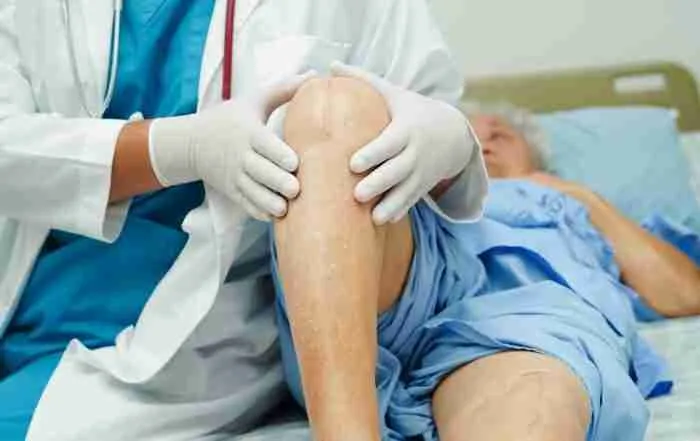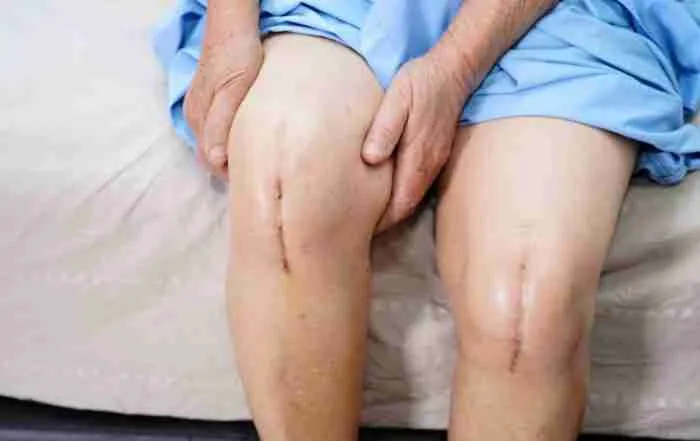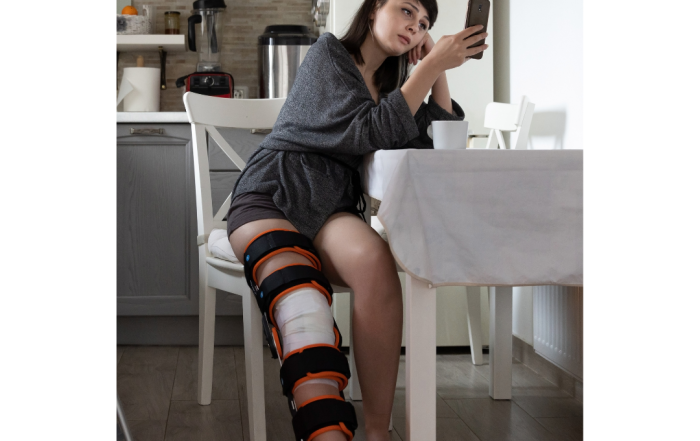Talk with Your Hip and Knee Expert Today!
Choose Dr. Morton as your Arthritis Doctor
- Experienced Orthopedic Surgeon
- Arthritis Specialist
- Nonoperative and Operative Treatment Available
- Evaluates each patient as a whole, not just their orthopedic problem
- Most Surgeries Are Same-Day, Outpatient surgeries
- High success rate in treating hip and knee pain
- Minimally invasive incision, smaller incisions
- Performs Anterior Total Hip Replacement, Minimally Invasive Total Knee Replacement and Partial Knee Replacements
- Robotic technology
- Latest Techniques
- Fellowship-trained and specialist in knee replacements
- Takes care of revision hip and knee replacements and complex joint replacements
Dr. Morton’s Guide To Knee Arthritis
This is a guide on the different treatment options available for your hip or knee pain
This guide will describe
- Prevalence of hip and knee arthritis
- Treatment strategies in traditional medicine
- Complementary medicine treatments
- Surgery if conservative treatment fails
If you want to learn how to stop arthritic pain and resume your life, you will want to read this guide.

Arthritis Facts
What is arthritis?
Arthritis is a severe disease of the joint that occurs when you have cartilage loss in your joint. The cartilage in your joint is a smooth surface that allows for easy movement of your joints. Unfortunately, when you lose cartilage, the joint begins to grind together and cause severe pain. A “joint” is the connection between two bones. The most common areas where arthritis occurs are your knees (between the femur and tibia) and hips (between the pelvis and the femur).
How common is arthritis?
- Arthritis is common, affecting 23% of people in the United States.
- Leading cause of work disability in the US
- Affects 8 million Americans
- Costs over $140 billion in the US healthcare costs.
- 60% of adults with arthritis are of working age between 18 and 64 years old.
- The hip and knee are the two most common joints affected by arthritis.

Types of Arthritis
Osteoarthritis
Rheumatoid Arthritis
Gout Arthritis
Post-Traumatic Arthritis
Septic Arthritis
Osteoarthritis
What is Osteoarthritis?
Osteoarthritis (OA) is the most common type of arthritis. This is not the same as “old age”. Some people are able to live a long and healthy lifestyle without arthritis. When this occurs, the joint can become very painful. Factors that can lead to osteoarthritis include age, genetics, being overweight, prior surgery, and history of injury
As the cartilage in your joint gets older, patients with arthritis will lose the ability to rebuild the cartilage in their joints. This occurs because of cartilage cell damage. The enzymes released from damaged cells disintegrate collagen and proteoglycan – the building blocks found in your cartilage. As a result, the cartilage present in the knee joint is destroyed.
The bone hardens, resulting in sclerosis. Increased pressure from hardened bones causes your body to form new bone, called “bone spurs”. Bone also becomes deteriorated, forming subchondral bone cysts. Eventually, your joint wears out, showing a “bone-on-bone” appearance on x-ray.
Stages
Osteoarthritis is clinically graded in five different stages depending on the disease progression.
Stage 0: Normal knee health. It is a good standard in which the knee joint demonstrates no signs of pain or impairment.
Stage 1: Minor bone spurs are observed. These are abnormal bone growths that develop where two ends of bones meet each other in the joint. No pain or impairment is seen.

Diagnosis
Blood Tests: There is no specific blood test for osteoarthritis; however, some blood tests help in ruling out other causes of joint pain, like rheumatoid arthritis.

Imaging Tests: X-rays show cartilage loss. Also, it can show bone spurs around the joint. MRI provides a detailed and refined image of bones and soft tissues of the affected area. An MRI is not usually required to diagnose osteoarthritis but can assist in providing detailed information in complex cases.
Rheumatoid Arthritis
What is Rheumatoid Arthritis?
Rheumatoid arthritis (RA) is a very common type of arthritis affecting people of different age groups.
Rheumatoid arthritis is a chronic inflammatory in which your body’s immune system is triggered and starts to attack the synovium (the soft tissue lining in your joints). Synovium is primarily is responsible for creating synovial fluid. Synovial fluid plays a crucial role in nourishing and lubricating the joints. Once the synovial membrane starts to get damaged, the cartilages and bones inside the joint begin to deteriorate. The person experiences pain when he/she performs movement at the affected joint, due to excessive wear and tear caused by increased friction. Rheumatoid arthritis may also involve organs such as skin, lungs, heart, and eyes. The exact cause of this autoimmune disorder is still not known, but scientists have identified genetic markers that increase the risk of developing rheumatoid arthritis by fivefold.
Stages
The prognosis of rheumatoid arthritis varies from person to person. It can demonstrate symptoms ranging from mild, moderate, to severe. There is no precise timeline for the progression of this disease. Without proper medical attention, the condition can worsen very quickly. Health professionals categorize rheumatoid arthritis into four major distinct stages.
Stage 1: Mild. The affected person experiences pain in the joint. The synovial membrane gets inflamed. Despite this initial inflammation, there is no damage to the bones.
Stage 2: Moderate. Joint inflammation begins to damage the cartilage present in joints. Once the cartilage is involved, the range of motion of the particular joint is limited. The person starts to experience pain upon moving the affected joint.
Stage 3: Severe. Now the damage is not only limited to the cartilage, bones start to show signs of degradation. Later in the stage, when bones completely lose the cushion between them, they start to rub together and soon erode. The joint motility is further regressed, and some people may experience muscular weakness.
Stage 4: End-stage. The joint no longer functions. Now, the joint doesn’t have inflammation. People may experience extreme pain, loss of motility, stiffness, swelling, and reduced muscle strength. Eventually, the bones of the joint are destroyed and may get fused (ankylosis).
Diagnosis
Diagnosis of rheumatoid arthritis is difficult to make in the early stages of the disease. There is no one physical finding or blood test that confirms the diagnosis. The final diagnosis is made based on a combination of clinical, laboratory, and imaging facilities.
Blood Tests: Rheumatoid arthritis causes an increase in the erythrocyte sedimentation rate (ESR). It also increases C-reactive protein (CRP). These results indicate that there is an on-going inflammatory process in the body. Rheumatoid factor and anti-cyclic citrullinated peptide (anti-CCP) antibodies are confirmatory tests.
Imaging Tests: X-rays help to track the progression of the disease while MRI and ultrasound aid the doctors to appreciate the severity of the disease in the body.
Gout Arthritis
What is Gout?
Gout is mostly considered as a disorder of uric acid or urate metabolism. The buildup of uric acid in the blood is mainly caused due to the breakdown of the purines.
Several factors can add up to the increased blood levels of uric acid. Metabolic disorders and dehydration can result in excess production of uric acid in your body. Moreover, kidney or thyroid problems or even an inherited metabolic disorder can make it difficult for your body to excrete excess uric acid. As a result, when uric acid accumulates in blood and body tissues as soon as the soft tissues become saturated, urate salt precipitate and form hard crystals that are highly insoluble in low temperatures and acidic conditions, i.e., peripheral joints.
The deposition of needle-like urate crystals in joint spaces and soft tissues inflicts serious damage to joints. These crystals cause increased friction during joint motion. They can damage the cartilage and bones associated with the affected joint.
Symptoms

Diagnosis
The definitive marker for the diagnosis of gout is the demonstrations of urate crystals in aspirated synovial fluid with a needle (arthrocentesis). The extracted fluid is carefully examined under a microscope, to identify the urate crystals in the sample.
Post-Traumatic Arthritis
What is Post-Traumatic Arthritis?
Post-traumatic arthritis develops due to wearing out of a joint that had previously sustain a physical injury. It may have been caused by a road accident, a fall, sports, military injury, etc. Such blunt physical injuries can damage the bone and cartilage, rendering the motion mechanics of the joint disturbed. Once the natural adjustment and alignment are deranged due to any external trauma, the joint wears out more quickly. Moreover, the wearing process is further accelerated due to high body weight. Often patients with post-traumatic arthritis have a more complex arthritic pattern that includes deformity and orthopedic implants. The surgical history sometimes makes the treatment of these patients more difficult than compared to patients with osteoarthritis.
Diagnosis
Imaging Tests: X-rays will give a clear picture of the condition of the joint. In some cases, a CT scan or MRI may be conducted.
Septic Arthritis
What is Septic Arthritis?
Septic arthritis or reactive arthritis is a term used to describe a form of joint inflammation that develops as a reaction to an infection. It is usually caused by a bacterial infection. The bacteria may gain entry into the body via blood-stream, direct penetration into the joint, or a surrounding infection in the bone or soft tissue near the joint. The joints with preexisting arthritis are at a significantly higher risk of developing bacterial arthritis. The most common bacterial culture responsible for this type of infectious arthritis is staphylococci. Once bacteria enter the joint, your body’s immune system will arrive, causing inflammation and attempt to attack the bacteria. During this process, the cartilage can be damaged, resulting in arthritis
Diagnosis
Lab Tests: ESR and CRP are two lab tests that may be obtained
Aspiration you may have a needle placed into your joint by a doctor to test the fluid for signs of bacteria
Treatment
The ultimate treatment of your infected joint is very challenging. Patients with a history of septic arthritis have a high risk of developing chronic pain. Joint replacements for patients with a history of septic arthritis are at high risk of failure and infection.
11 Ways to Treat Arthritis Without Surgery
Treatment for arthritis begins with non-operative treatments. There is a good chance that we can improve your pain without surgery.
1. Non-Steroidal Anti-Inflammatory Drugs (NSAIDs)
NSAIDs are medications reduce that inflammation and pain by blocking pain receptors in your musculoskeletal system. Examples include ibuprofen and naproxen.
2. Tylenol (Acetaminophen)
Tylenol works by blocking opioid receptors in the brain. By stopping these receptors, Tylenol stops the release of neurotransmitters such as Substance P – a molecule responsible for pain. It is an inexpensive over-the-counter pain-reliever.
3. Corticosteroid Injections (Steroid Injections)
Steroid injections into your joint reduces your inflammation. Often patients have a lasting effect. Usually these injections can be provided every 3 months. Many patients will find great success with treatment that occurs on an annual or semi-annual basis.
4. Weight Management
Decreasing your weight reduces the stress on your joint. Every pound carried on your body is equivalent to 4 pounds on your knees.
5. Exercise and Physical Therapy
Building muscle is an incredibly effective way to improve the pain in your joints. Working with therapists can help develop muscles involved hip and knee function. This improvement in strength reduces the stress put across your joint. Stretching helps with making your joints more flexible and less stiff.
6. Walkers and Canes
Gait aids provide improved mobility and support for patients that need them.
7. Activity Modification
High-impact activities such as jogging on joints that are worn-out may cause pain and possibly damage to your cartilage. Having reasonable expectations of your arthritic joint may allow you to have a pain-free experience.
8. Viscosupplementation or Hyaluronic Acid Injections (Gel Shots)
These types of injections may provide cushion or lubrication to the joint. The FDA has approved these medications for knee injections. There have been several medical journal studies that have published on these types of injections. Some studies have shown improvements in pain, while some have shown no improvements
9. Anti-Rheumatic Medications
These medications have been game-changers in patient’s lives and pain control. Patients who have gout, rheumatoid or other inflammatory arthritis should consider evaluation by a rheumatologist for co-management of their pain.
10. Anti-Gout Medications
The treatment options for gouty arthritis mainly divide into one of the three groups: uric-acid -lowering medication, urate-lowering medications (allopurinol, febuxostat, probenecid), and prophylactic medications. Dietary changes are recommended to patients suffering for gouty arthritis; the intake of food that adds uric acid content in blood needs to be minimized, i.e., red meat, liver, kidneys, sugary drinks, and foods rich in fructose.
What’s New in Nonoperative Arthritis Treatment?
11. Radiofrequency Ablation
Radiofrequency ablation is a technique by which a probe is inserted near a nerve and delivers radiofrequency energy, causing ionic heat to create a lesion into the nerve. By creating a lesion in the nerve, it prevents the transfer of pain signals from your arthritic knee. This prevents you from feeling the pain. Radiofrequency ablation requires anesthesia for the insertion of the probe. Some patients notice pain relief for up to two years.
12. TENS Unit
TENS units (Transcutaneous Electrical Nerve Stimulation) are often provided in physical therapist office to help with stimulation of muscle for muscle building and pain relief. Some patients have noticed that purchasing a portable take-home unit provides them with pain relief without the use of medications or procedures. TENS unit deliver electricity to electrode pads that are applied to the skin. This electrical stimulation will cause muscle contractions. Some patients notice an improvement in their overall pain control through this process.
Complementary and Alternative Medicine (CAM) Treatments for Arthritis

When is it Time to Consider Surgery for Arthritis?

Frequently Asked Questions about Hip and Knee Arthritis (FAQ)
Physicians recommend the combination of exercise, weight loss, self-management programs, tai chi, cane use, topical NSAIDs, and glucocorticoid injections. They also state that some people may benefit from balance exercises and cognitive behavioral therapy.
Weather changes cause a change in barometric pressure. Cold and damp weather can cause your joint to feel swollen and painful. Many patients who move from colder climates feel an improvement in their hip or knee pain.
Arthritis can be triggered by increased stress across the joint such as trauma, overdoing your normal activities, cold weather, elevated weight, or repetitive motions.
While injections, medications, and small procedures have been able to help with temporary relief of pain, the most effective treatment is a hip or knee replacements. For many patients, joint replacements are able to provide long-lasting pain relief and help them return to normal.
Science has been looking for a cure for arthritis for a long time. At this point, we have very good treatments that alleviate pain and inflammation. Nonoperative treatment for arthritis helps people stay active with their normal knees for a longer time, sometimes avoiding surgery altogether. There are excellent surgical treatments available to help with arthritis.
Related Pages
Personalized Alignment In Knee Replacement Surgery
Knee replacement surgery has long been a solution for patients who have severe arthritis or joint degeneration. Traditionally, the procedure has involved using standardized techniques to position the knee implant. However, personalized alignment in knee [...]
Hiking After Knee Replacement: Tips for Staying Active
Knee replacement surgery can be life-changing, offering significant relief from pain and improved mobility. However, returning to physical activities like hiking may seem daunting for many. However, hiking after knee replacement is possible—and even beneficial [...]
Uncemented Knee Replacement: What Patients Should Know
Knee replacement surgery has evolved significantly over the years, with various techniques and approaches tailored to meet individual patient needs. Among these, uncemented knee replacement is gaining attention as an alternative to the traditional [...]
How Much Does A Hip Or Knee Replacement Cost?
Understanding Your Expected Bills Hip or knee replacement surgery is a transformative procedure that can significantly improve the quality of life for individuals with severe arthritis or joint damage. However, the financial aspect [...]
Cost of Total Knee Replacement in Hawaii for Medicare Patients: How to Save Money with Outpatient Surgery Centers
Total knee replacement (TKA) is a life-changing procedure for patients suffering from severe arthritis or knee dysfunction. With advancements in surgical techniques, many TKAs are now performed on an outpatient basis, allowing patients to [...]
Understanding Post-Traumatic Arthritis After ACL Reconstruction
Anterior Cruciate Ligament (ACL) injuries are a common occurrence, especially among athletes and physically active individuals. While ACL reconstruction is a widely accepted procedure to restore knee stability and function, it is important to [...]







